苏联解体英文介绍
- 格式:ppt
- 大小:258.50 KB
- 文档页数:34
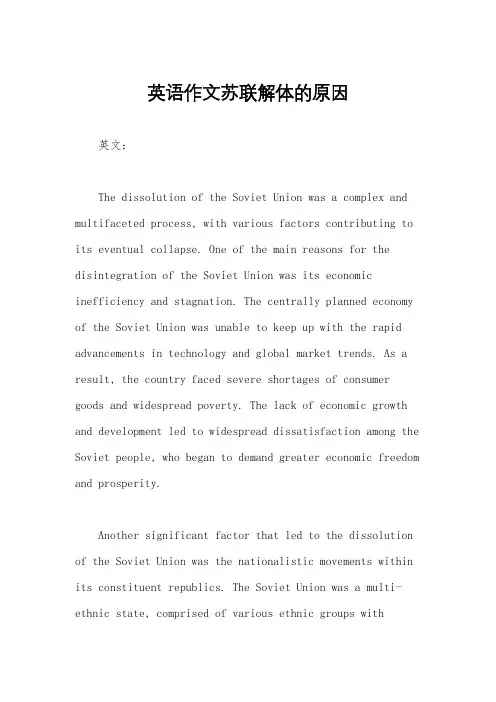
英语作文苏联解体的原因英文:The dissolution of the Soviet Union was a complex and multifaceted process, with various factors contributing to its eventual collapse. One of the main reasons for the disintegration of the Soviet Union was its economic inefficiency and stagnation. The centrally planned economy of the Soviet Union was unable to keep up with the rapid advancements in technology and global market trends. As a result, the country faced severe shortages of consumer goods and widespread poverty. The lack of economic growth and development led to widespread dissatisfaction among the Soviet people, who began to demand greater economic freedom and prosperity.Another significant factor that led to the dissolution of the Soviet Union was the nationalistic movements within its constituent republics. The Soviet Union was a multi-ethnic state, comprised of various ethnic groups withdistinct cultures, languages, and histories. As the Soviet government began to lose its grip on power, many of these ethnic groups sought greater autonomy and independence.This led to the rise of nationalist movements in republics such as Ukraine, Lithuania, and Estonia, which eventually declared their independence from the Soviet Union.Furthermore, the policies of Soviet leaders, such as Mikhail Gorbachev, also played a crucial role in the dissolution of the Soviet Union. Gorbachev's attempts to reform the Soviet system through policies such as glasnost (openness) and perestroika (restructuring) inadvertently weakened the authority of the central government and emboldened nationalist movements. The loosening ofpolitical restrictions and censorship allowed for the emergence of alternative political ideologies and movements, further destabilizing the Soviet regime.In addition to these internal factors, external pressures also contributed to the collapse of the Soviet Union. The arms race with the United States and its NATO allies placed a significant strain on the Soviet economy,diverting resources away from essential social and economic needs. The Soviet Union's involvement in costly military interventions, such as the war in Afghanistan, further exacerbated its economic woes and weakened itsinternational standing.Ultimately, the combination of economic inefficiency, nationalist movements, and misguided policies led to the dissolution of the Soviet Union in 1991. The collapse of the Soviet Union had far-reaching consequences, not onlyfor the former Soviet republics but also for the global geopolitical landscape.中文:苏联解体是一个复杂而多方面的过程,有各种因素导致了它最终的崩溃。

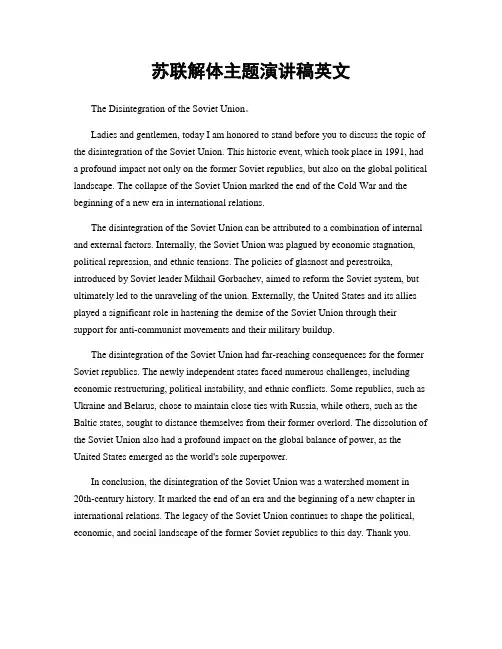
苏联解体主题演讲稿英文The Disintegration of the Soviet Union。
Ladies and gentlemen, today I am honored to stand before you to discuss the topic of the disintegration of the Soviet Union. This historic event, which took place in 1991, had a profound impact not only on the former Soviet republics, but also on the global political landscape. The collapse of the Soviet Union marked the end of the Cold War and the beginning of a new era in international relations.The disintegration of the Soviet Union can be attributed to a combination of internal and external factors. Internally, the Soviet Union was plagued by economic stagnation, political repression, and ethnic tensions. The policies of glasnost and perestroika, introduced by Soviet leader Mikhail Gorbachev, aimed to reform the Soviet system, but ultimately led to the unraveling of the union. Externally, the United States and its allies played a significant role in hastening the demise of the Soviet Union through their support for anti-communist movements and their military buildup.The disintegration of the Soviet Union had far-reaching consequences for the former Soviet republics. The newly independent states faced numerous challenges, including economic restructuring, political instability, and ethnic conflicts. Some republics, such as Ukraine and Belarus, chose to maintain close ties with Russia, while others, such as the Baltic states, sought to distance themselves from their former overlord. The dissolution of the Soviet Union also had a profound impact on the global balance of power, as the United States emerged as the world's sole superpower.In conclusion, the disintegration of the Soviet Union was a watershed moment in20th-century history. It marked the end of an era and the beginning of a new chapter in international relations. The legacy of the Soviet Union continues to shape the political, economic, and social landscape of the former Soviet republics to this day. Thank you.。
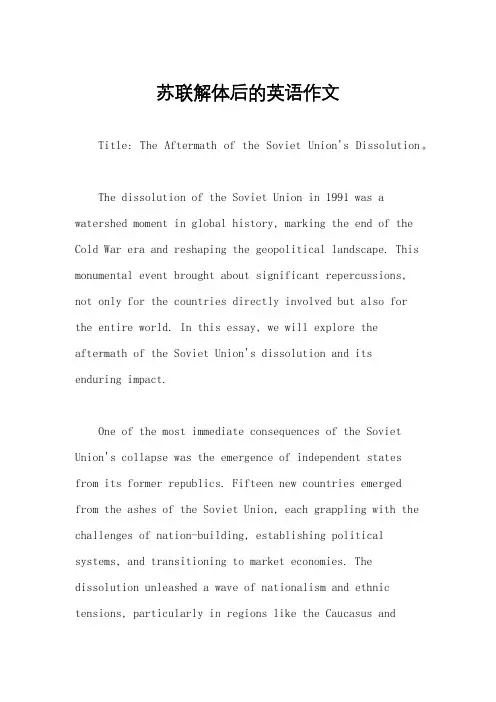
苏联解体后的英语作文Title: The Aftermath of the Soviet Union's Dissolution。
The dissolution of the Soviet Union in 1991 was a watershed moment in global history, marking the end of the Cold War era and reshaping the geopolitical landscape. This monumental event brought about significant repercussions,not only for the countries directly involved but also forthe entire world. In this essay, we will explore the aftermath of the Soviet Union's dissolution and itsenduring impact.One of the most immediate consequences of the Soviet Union's collapse was the emergence of independent states from its former republics. Fifteen new countries emerged from the ashes of the Soviet Union, each grappling with the challenges of nation-building, establishing political systems, and transitioning to market economies. The dissolution unleashed a wave of nationalism and ethnic tensions, particularly in regions like the Caucasus andCentral Asia, where longstanding grievances resurfaced.Economically, the dissolution of the Soviet Union precipitated a period of profound upheaval. The centrally planned economy of the Soviet era gave way to the complexities of a market economy, leading to widespread economic dislocation and hardship. The sudden shift from state-controlled industries to privatization brought both opportunities and hardships, with some individuals amassing vast wealth while others faced unemployment and poverty.Internationally, the end of the Cold War ushered in a new era of geopolitical dynamics. With the demise of the Soviet bloc, the United States emerged as the sole superpower, leading to a unipolar world order characterized by American hegemony. This shift in power dynamics had far-reaching implications for global politics, with the United States exerting influence over regions formerly within the Soviet sphere of influence.Furthermore, the dissolution of the Soviet Union had profound implications for global security. The end of theCold War reduced the risk of nuclear confrontation between the United States and the Soviet Union, easing tensions and paving the way for arms control agreements such as the Strategic Arms Reduction Treaty (START). However, it also created new security challenges, including theproliferation of nuclear weapons and the rise of non-state actors.Moreover, the dissolution of the Soviet Union had a profound impact on the lives of its citizens. While some experienced newfound freedoms and opportunities, others grappled with economic uncertainty, social upheaval, and political instability. The transition from communism to democracy was not without its challenges, as many struggled to adapt to the demands of a new political and economic system.In conclusion, the dissolution of the Soviet Union was a seismic event that reverberated across the globe, reshaping political, economic, and security landscapes. While it brought about newfound freedoms for some, it also unleashed a host of challenges, from economic upheaval togeopolitical realignments. The legacy of the Soviet Union's dissolution continues to shape the world we live in today, underscoring the enduring impact of this historic event.。
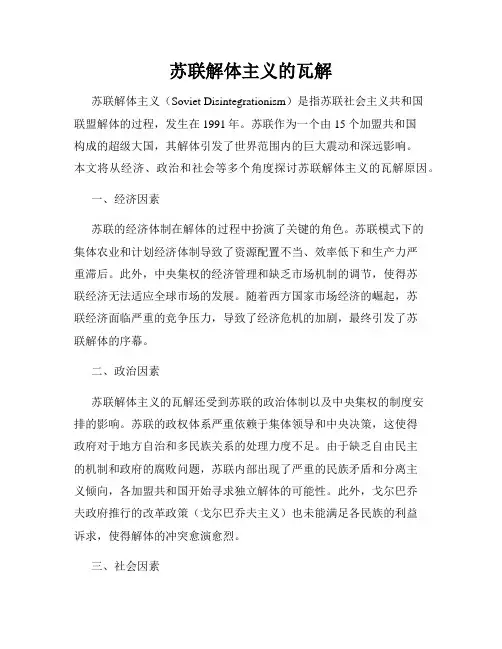
苏联解体主义的瓦解苏联解体主义(Soviet Disintegrationism)是指苏联社会主义共和国联盟解体的过程,发生在1991年。
苏联作为一个由15个加盟共和国构成的超级大国,其解体引发了世界范围内的巨大震动和深远影响。
本文将从经济、政治和社会等多个角度探讨苏联解体主义的瓦解原因。
一、经济因素苏联的经济体制在解体的过程中扮演了关键的角色。
苏联模式下的集体农业和计划经济体制导致了资源配置不当、效率低下和生产力严重滞后。
此外,中央集权的经济管理和缺乏市场机制的调节,使得苏联经济无法适应全球市场的发展。
随着西方国家市场经济的崛起,苏联经济面临严重的竞争压力,导致了经济危机的加剧,最终引发了苏联解体的序幕。
二、政治因素苏联解体主义的瓦解还受到苏联的政治体制以及中央集权的制度安排的影响。
苏联的政权体系严重依赖于集体领导和中央决策,这使得政府对于地方自治和多民族关系的处理力度不足。
由于缺乏自由民主的机制和政府的腐败问题,苏联内部出现了严重的民族矛盾和分离主义倾向,各加盟共和国开始寻求独立解体的可能性。
此外,戈尔巴乔夫政府推行的改革政策(戈尔巴乔夫主义)也未能满足各民族的利益诉求,使得解体的冲突愈演愈烈。
三、社会因素苏联解体的社会因素主要包括民族冲突、经济不平等和思想解放等方面。
苏联内部的民族冲突在解体的过程中迅速升级,各族群之间的对立和仇视导致了联盟的崩溃。
此外,经济的不平等也是苏联解体的重要原因之一。
各加盟共和国在经济资源的分配上存在明显的不公平,导致了地区之间的经济发展差距越来越大。
最后,苏联的解体主义还受到思想解放运动的影响。
苏联人民对于民主、自由和个人权利的渴望日益增长,这种思潮对于解体的推动起到了重要的作用。
结论苏联解体主义的瓦解可以归因于多种因素的交织作用。
经济困境、政治体制问题和社会矛盾的加剧共同导致了苏联的解体。
通过对这些因素的理解和分析,我们可以更好地认识到苏联解体背后的复杂性和深远影响。
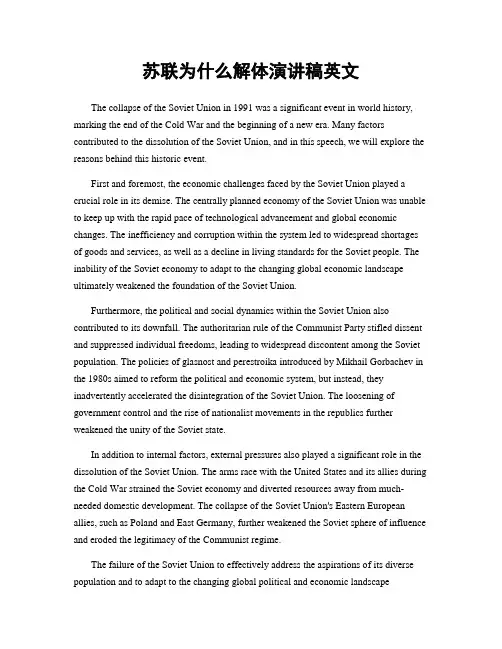
苏联为什么解体演讲稿英文The collapse of the Soviet Union in 1991 was a significant event in world history, marking the end of the Cold War and the beginning of a new era. Many factors contributed to the dissolution of the Soviet Union, and in this speech, we will explore the reasons behind this historic event.First and foremost, the economic challenges faced by the Soviet Union played a crucial role in its demise. The centrally planned economy of the Soviet Union was unable to keep up with the rapid pace of technological advancement and global economic changes. The inefficiency and corruption within the system led to widespread shortages of goods and services, as well as a decline in living standards for the Soviet people. The inability of the Soviet economy to adapt to the changing global economic landscape ultimately weakened the foundation of the Soviet Union.Furthermore, the political and social dynamics within the Soviet Union also contributed to its downfall. The authoritarian rule of the Communist Party stifled dissent and suppressed individual freedoms, leading to widespread discontent among the Soviet population. The policies of glasnost and perestroika introduced by Mikhail Gorbachev in the 1980s aimed to reform the political and economic system, but instead, they inadvertently accelerated the disintegration of the Soviet Union. The loosening of government control and the rise of nationalist movements in the republics further weakened the unity of the Soviet state.In addition to internal factors, external pressures also played a significant role in the dissolution of the Soviet Union. The arms race with the United States and its allies during the Cold War strained the Soviet economy and diverted resources away from much-needed domestic development. The collapse of the Soviet Union's Eastern European allies, such as Poland and East Germany, further weakened the Soviet sphere of influence and eroded the legitimacy of the Communist regime.The failure of the Soviet Union to effectively address the aspirations of its diverse population and to adapt to the changing global political and economic landscapeultimately led to its dissolution. The legacy of the Soviet Union continues to shape the geopolitical dynamics of the world today, and its collapse serves as a cautionary tale of the consequences of political and economic stagnation.In conclusion, the collapse of the Soviet Union was the result of a complex interplay of economic, political, and social factors, as well as external pressures. The inability of the Soviet Union to adapt to the changing global landscape and address the aspirations of its diverse population ultimately led to its demise. The lessons learned from the collapse of the Soviet Union continue to be relevant in today's world, serving as a reminder of the importance of adaptability and responsiveness to the needs of the people. Thank you.。
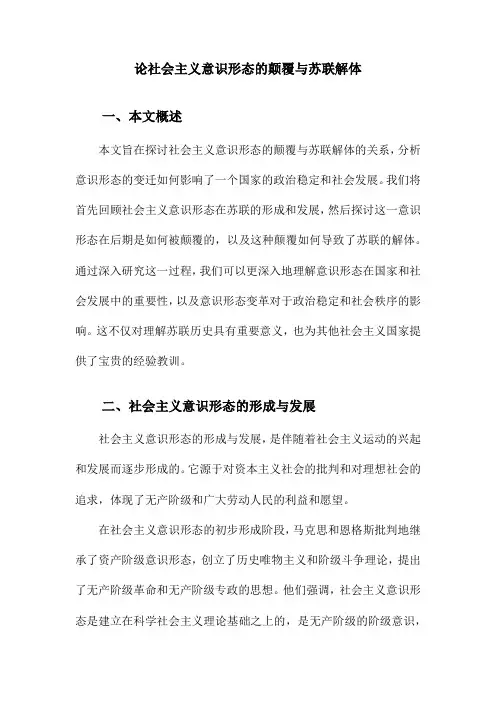
论社会主义意识形态的颠覆与苏联解体一、本文概述本文旨在探讨社会主义意识形态的颠覆与苏联解体的关系,分析意识形态的变迁如何影响了一个国家的政治稳定和社会发展。
我们将首先回顾社会主义意识形态在苏联的形成和发展,然后探讨这一意识形态在后期是如何被颠覆的,以及这种颠覆如何导致了苏联的解体。
通过深入研究这一过程,我们可以更深入地理解意识形态在国家和社会发展中的重要性,以及意识形态变革对于政治稳定和社会秩序的影响。
这不仅对理解苏联历史具有重要意义,也为其他社会主义国家提供了宝贵的经验教训。
二、社会主义意识形态的形成与发展社会主义意识形态的形成与发展,是伴随着社会主义运动的兴起和发展而逐步形成的。
它源于对资本主义社会的批判和对理想社会的追求,体现了无产阶级和广大劳动人民的利益和愿望。
在社会主义意识形态的初步形成阶段,马克思和恩格斯批判地继承了资产阶级意识形态,创立了历史唯物主义和阶级斗争理论,提出了无产阶级革命和无产阶级专政的思想。
他们强调,社会主义意识形态是建立在科学社会主义理论基础之上的,是无产阶级的阶级意识,旨在推翻资本主义制度,建立社会主义和共产主义制度。
随着社会主义实践的不断深入,社会主义意识形态也在不断发展。
列宁领导了俄国十月革命,建立了世界上第一个社会主义国家,为社会主义意识形态的发展提供了实践基础。
在社会主义建设过程中,列宁强调了意识形态工作的重要性,提出了“政治工作是一切经济工作的生命线”的著名论断。
他主张通过意识形态工作来凝聚无产阶级和广大劳动人民的意志和力量,推动社会主义事业的发展。
在社会主义国家建立后,社会主义意识形态在国家政治生活中占据了主导地位。
它强调社会主义制度的优越性和无产阶级的领导地位,倡导集体主义、爱国主义和无私奉献等价值观念,为社会主义事业提供了强大的精神动力。
同时,社会主义意识形态也面临着各种挑战和考验,如资本主义意识形态的渗透、国内外敌对势力的破坏等。
因此,社会主义国家必须不断加强意识形态工作,巩固社会主义意识形态的主导地位。
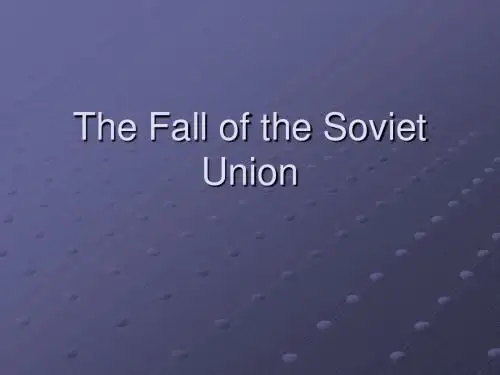
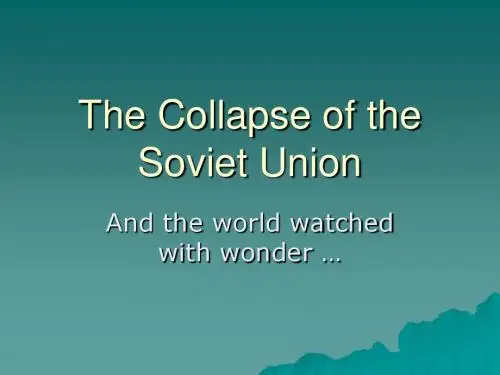
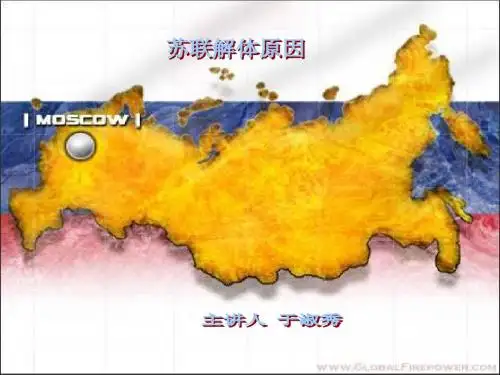
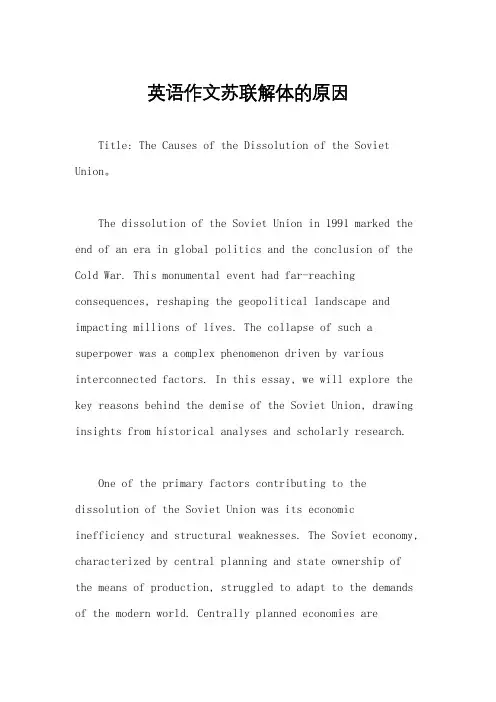
英语作文苏联解体的原因Title: The Causes of the Dissolution of the Soviet Union。
The dissolution of the Soviet Union in 1991 marked the end of an era in global politics and the conclusion of the Cold War. This monumental event had far-reaching consequences, reshaping the geopolitical landscape and impacting millions of lives. The collapse of such a superpower was a complex phenomenon driven by various interconnected factors. In this essay, we will explore the key reasons behind the demise of the Soviet Union, drawing insights from historical analyses and scholarly research.One of the primary factors contributing to the dissolution of the Soviet Union was its economic inefficiency and structural weaknesses. The Soviet economy, characterized by central planning and state ownership of the means of production, struggled to adapt to the demands of the modern world. Centrally planned economies areinherently inefficient due to their inability to allocate resources effectively and respond to market signals. The Soviet Union's reliance on heavy industry and military expenditure drained resources from more productive sectors, leading to stagnation and declining living standards forits citizens.Moreover, the inefficiencies of the Soviet economy were exacerbated by systemic corruption and bureaucratic mismanagement. The centralization of power in the hands of the Communist Party elite fostered a culture of nepotism and cronyism, where party officials prioritized personal gain over the common good. This pervasive corruption undermined public trust in the government and hindered efforts to implement meaningful reforms.Another critical factor in the dissolution of the Soviet Union was the erosion of ideological legitimacy and the loss of public support. The Communist Party's monopoly on power was challenged by growing dissent and disillusionment among the populace. Years of propaganda and censorship could not conceal the failures of the Sovietsystem, as people became increasingly aware of its shortcomings and injustices. The ideals of Marxism-Leninism lost their appeal in the face of economic hardship,political repression, and social inequality.Furthermore, the Soviet Union's demise was hastened by the rise of nationalist movements within its constituent republics. Ethnic tensions simmered beneath the surface for decades, suppressed by the authoritarian regime. However, the policies of glasnost (openness) and perestroika (restructuring) introduced by Mikhail Gorbachev in the 1980s inadvertently unleashed long-suppressed nationalist sentiments. Republics such as Lithuania, Latvia, and Estonia sought greater autonomy and eventually declared independence, sparking a chain reaction that culminated in the dissolution of the union.The geopolitical dynamics of the Cold War also played a significant role in the Soviet Union's collapse. The arms race and proxy conflicts with the United States strained the Soviet economy and drained its resources. The reforms initiated by Gorbachev, intended to revitalize the Sovietsystem, inadvertently weakened its grip on Eastern Europe. The unraveling of communist regimes in Poland, Hungary, East Germany, and other Eastern Bloc countries signaled the waning influence of the Soviet Union in the region.Additionally, external factors such as the decliningoil prices and the loss of strategic allies further undermined the Soviet Union's stability. The collapse of the oil market in the 1980s dealt a severe blow to the Soviet economy, which heavily relied on oil exports to finance its activities. Meanwhile, the loss of client states in Eastern Europe and the dissolution of the Warsaw Pact deprived the Soviet Union of its buffer zone and geopolitical leverage.In conclusion, the dissolution of the Soviet Union was a multifaceted process driven by economic, political, social, and geopolitical factors. The combination of economic inefficiency, ideological decay, nationalist aspirations, and external pressures ultimately proved insurmountable for the Soviet regime. The collapse of such a formidable superpower reshaped the global order andmarked the end of the Cold War era, leaving a profound impact on world history.。
苏联解体历史小作文英文下载温馨提示:该文档是我店铺精心编制而成,希望大家下载以后,能够帮助大家解决实际的问题。
文档下载后可定制随意修改,请根据实际需要进行相应的调整和使用,谢谢!并且,本店铺为大家提供各种各样类型的实用资料,如教育随笔、日记赏析、句子摘抄、古诗大全、经典美文、话题作文、工作总结、词语解析、文案摘录、其他资料等等,如想了解不同资料格式和写法,敬请关注!Download tips: This document is carefully compiled by theeditor. I hope that after you download them,they can help yousolve practical problems. The document can be customized andmodified after downloading,please adjust and use it according toactual needs, thank you!In addition, our shop provides you with various types ofpractical materials,such as educational essays, diaryappreciation,sentence excerpts,ancient poems,classic articles,topic composition,work summary,word parsing,copyexcerpts,other materials and so on,want to know different data formats andwriting methods,please pay attention!The dissolution of the Soviet Union was a major event in world history. It marked the end of the Cold War and the beginning of a new era in international relations.The Soviet Union had been a superpower for decades, but by the late 1980s, it was clear that the country was in decline. Economic problems, political unrest, and ethnic tensions all contributed to the eventual breakup of the USSR.The dissolution of the Soviet Union had far-reaching consequences. It led to the independence of 15 new countries, including Russia, Ukraine, and Kazakhstan. It also changed the balance of power in the world, as the United States emerged as the sole superpower.The end of the Soviet Union also had a profound impact on the lives of millions of people. Many faced economic hardship and uncertainty as their countries transitioned toa new political and economic system. The dissolution of the USSR also had a lasting impact on global politics, as new alliances and rivalries emerged in the post-Soviet era.Overall, the dissolution of the Soviet Union was a watershed moment in world history. It marked the end of an era and the beginning of a new chapter in international relations.。
苏联解体成个国家的笔记苏联解体是指苏联社会主义国家体系的崩溃与瓦解,其中包括苏联的政治解体、经济解体、军事解体和民族解体。
以下是苏联解体后形成的主要国家的简要概述:1. 俄罗斯联邦(Russia):苏联解体后,俄罗斯成为苏联的继任国家,并且保留了苏联时期的国家机构和领土。
俄罗斯是一个联邦国家,由85个联邦主体组成,其中包括21个共和国。
2. 乌克兰(Ukrne):乌克兰是苏联解体后最大的独立国家之一,拥有丰富的农业和工业资源。
然而,乌克兰在独立后面临了许多经济和政治挑战,包括与俄罗斯的冲突以及东部地区的争议。
3. 白俄罗斯(Belarus):白俄罗斯是苏联解体后的另一个独立国家,政治体制较为专制。
白俄罗斯与俄罗斯保持密切的经济和政治联系,两国签署了加强经济合作的联盟条约。
4. 哈萨克斯坦(Kazakhstan):哈萨克斯坦是亚洲面积最大的国家之一,拥有丰富的能源资源。
在独立后,哈萨克斯坦在经济和政治改革方面取得了一定的成就,成为中亚地区的重要力量。
5. 乌兹别克斯坦(Uzbekistan):乌兹别克斯坦是中亚地区最人口密集的国家之一,拥有丰富的自然资源和农业产能。
然而,乌兹别克斯坦的政治局势相对较稳定,民主改革进展有限。
6. 吉尔吉斯斯坦(Kyrgyzstan):吉尔吉斯斯坦是一个中亚的内陆国家,曾经经历过政治动荡和领导人更迭。
吉尔吉斯斯坦在转型期间面临了许多经济和政治挑战,包括贫困、腐败和民主发展。
7. 阿塞拜疆(Azerbjan):阿塞拜疆是南高加索地区的一个国家,拥有丰富的石油和天然气资源。
阿塞拜疆在苏联解体后经历了一系列与亚美尼亚的领土冲突,但成功地稳定了国内政治和经济局势。
8. 格鲁吉亚(Georgia):格鲁吉亚是南高加索地区的一个国家,曾经是苏联的一个加盟共和国。
格鲁吉亚在独立后面临了与俄罗斯的持续冲突,以及一系列政治动荡和经济困境。
除了上述国家,其他一些苏联解体后成立的国家还包括亚美尼亚(Armenia)、摩尔多瓦(Moldova)、塔吉克斯坦(Tajikistan)等。
英语作文苏联解体了吗The dissolution of the Soviet Union was a significant event that reshaped the geopolitical landscape of the late 20th century. The question of whether the Soviet Union has truly dissolved is complex and multifaceted, involving political, economic, and social dimensions.In December 1991, the leaders of three Slavic republics—Russia, Ukraine, and Belarus—signed the Belavezha Accords, declaring the dissolution of the Soviet Union and establishing the Commonwealth of Independent States (CIS) in its place. This marked the formal end of the Soviet Union as a political entity. However, the process of dissolution was not straightforward, and its effects continue to reverberate in the post-Soviet space.Firstly, while the Soviet Union ceased to exist as a centralized state, its legacy still influences politics and society in the former Soviet republics. Many of these countries continue to grapple with the challenges oftransitioning from a centrally planned economy to a market-based system. The dissolution of the Soviet Union also ledto the emergence of new states, each with its own national identity and geopolitical aspirations. Conflicts over territory, ethnicity, and resources have plagued several post-Soviet states, undermining stability and hindering economic development.Furthermore, the dissolution of the Soviet Union didnot eradicate all vestiges of its influence. Russia, as the largest successor state, has sought to maintain its sphereof influence in the post-Soviet space through various means, including economic partnerships, military interventions,and political alliances. The annexation of Crimea in 2014 and ongoing tensions in eastern Ukraine are stark reminders of the enduring geopolitical rivalries stemming from the Soviet era.Economically, the transition from communism tocapitalism has been uneven across the former Soviet republics. While some countries, such as the Baltic states and Georgia, have successfully implemented market reformsand achieved significant economic growth, others have struggled with corruption, poverty, and stagnation. The privatization of state-owned enterprises, often accompanied by insider deals and crony capitalism, has contributed to widening economic disparities and social discontent.Socially, the dissolution of the Soviet Union has reshaped identities and relationships within and between the successor states. The collapse of the Soviet ideology and state apparatus has created a vacuum that has beenfilled by a resurgence of nationalism, ethnic tensions, and competing historical narratives. Minority rights, language policies, and historical grievances have become flashpoints for conflict, undermining efforts to foster reconciliation and cooperation.In conclusion, while the formal dissolution of the Soviet Union occurred in 1991, its effects continue to be felt in the post-Soviet space today. The legacy of the Soviet era, both positive and negative, shapes politics, economics, and society in the former Soviet republics. Whether the Soviet Union has truly dissolved depends onone's perspective: while it no longer exists as a unified political entity, its influence persists in myriad ways, shaping the dynamics of the region for years to come.。
英语作文苏联解体Title: The Dissolution of the Soviet Union: AHistorical Turning Point。
The dissolution of the Soviet Union marked a pivotal moment in world history, reshaping geopolitics and international relations in profound ways. From its emergence as a global superpower after World War II to its eventual collapse in 1991, the Soviet Union's demise hadfar-reaching implications across political, economic, and social spheres.First and foremost, the dissolution of the Soviet Union fundamentally altered the geopolitical landscape of the world. For much of the latter half of the 20th century, the Cold War rivalry between the United States and the Soviet Union defined global politics. The collapse of the Soviet Union effectively ended this bipolar power structure, leading to the emergence of the United States as the sole superpower on the world stage. This shift in power dynamicshad significant implications for international relations,as it reshaped alliances, security arrangements, and diplomatic strategies.Economically, the dissolution of the Soviet Union had profound consequences for the newly independent states that emerged from its ashes. The Soviet economy had long been characterized by central planning, state ownership of industry, and inefficiency. The transition to a market-oriented economy was fraught with challenges, including hyperinflation, unemployment, and widespread poverty. Manyof the newly independent states struggled to adapt to the demands of the global market economy, leading to economic stagnation and social unrest in some cases.Socially, the dissolution of the Soviet Union unleashed a wave of nationalism and ethnic conflict across the region. As former Soviet republics asserted their independence,long-suppressed ethnic tensions resurfaced, leading to violence and bloodshed in places like the Caucasus and Central Asia. The collapse of the Soviet Union also precipitated mass migration as people sought betteropportunities and greater freedoms in newly independent states or abroad.The dissolution of the Soviet Union also hadimplications for global security. With the demise of the Soviet Union, nuclear proliferation became a major concern as former Soviet republics inherited vast nuclear arsenals. Efforts to secure and dismantle these weapons of mass destruction became a top priority for the international community to prevent them from falling into the wrong hands. Additionally, the collapse of the Soviet Union created new security challenges, including the proliferation of transnational crime, terrorism, and regional conflicts.In conclusion, the dissolution of the Soviet Union wasa watershed moment in world history with far-reaching implications across political, economic, and social dimensions. It marked the end of the Cold War era and the emergence of a new global order dominated by the United States. However, the legacy of the Soviet Union continuesto shape the geopolitical landscape of Eurasia and beyond,reminding us of the complex interplay of history, ideology, and power in shaping the course of human events.。
苏联开始解体英语作文The Beginning of the Disintegration of the Soviet Union。
The Soviet Union was once a superpower that dominatedthe world stage. However, in the late 1980s, the country began to experience a series of political, economic, and social changes that led to its eventual disintegration.This essay will explore the events that led to the downfall of the Soviet Union.One of the main factors that contributed to thecollapse of the Soviet Union was the economic stagnationthat plagued the country in the 1980s. The Soviet economy was heavily centralized and controlled by the government, which led to inefficiencies and a lack of innovation. Additionally, the country was heavily dependent on oil exports, and when oil prices fell in the 1980s, the Soviet economy suffered greatly.Another key factor was the political reforms that wereintroduced by Soviet leader Mikhail Gorbachev. Gorbachev's policies of glasnost (openness) and perestroika (restructuring) aimed to modernize the Soviet Union and make it more democratic. However, these reforms also led to increased political instability and unrest, as different groups within the country began to demand greater autonomy and independence.The Baltic states, in particular, were at the forefront of the movement for independence. Estonia, Latvia, and Lithuania had been annexed by the Soviet Union in 1940, and their populations had long resented Soviet rule. In thelate 1980s, these countries began to demand greater autonomy, and eventually, full independence. This movement inspired other regions within the Soviet Union to demand greater autonomy as well.The disintegration of the Soviet Union was also influenced by external factors. The United States, under President Ronald Reagan, had pursued a policy of aggressive anti-communism, which put pressure on the Soviet Union to reform. Additionally, the Soviet Union was heavily involvedin the Cold War, and the arms race with the United States had drained the country's resources.In 1991, the Soviet Union officially dissolved, marking the end of an era. The country was replaced by a number of independent states, including Russia, Ukraine, and Kazakhstan. The collapse of the Soviet Union had far-reaching consequences, both for the people of the former Soviet republics and for the world as a whole.In conclusion, the disintegration of the Soviet Union was a complex process that was influenced by a number of factors. Economic stagnation, political reforms, demandsfor greater autonomy, and external pressures all played a role in the downfall of the Soviet Union. While the collapse of the Soviet Union was a momentous event, it also marked the beginning of a new era in world history.。
蘇聯解體此條目沒有列出任何參考或來源。
(2007年8月)請協助添加來自可靠來源的引用以改善這篇條目。
無法查證的內容可能被提出異議而移除。
目錄[隱藏]∙ 1 蘇聯解體的原因∙ 2 八一九事件∙ 3 各加盟共和國的獨立∙ 4 蘇聯的終結∙ 5 影響o 5.1 政治o 5.2 經濟o 5.3 文化∙ 6 註釋∙7 相關連結[此條目或章節可能包含原創研究或未查證內容。
請協助添加參考資料以改善這篇條目。
詳細情況請參見討論頁。
八一九事件時的莫斯科街頭坦克1991年8月19日,蘇共中的保守派發動了一場不成功的政變,軟禁了當時正在黑海畔渡假的蘇聯總統戈巴契夫,試圖收回下放給加盟共和國的權力,同時終止不成功的經濟改革。
但是在人民、軍隊和大多數蘇共黨員的聯合反對下,政變僅僅維持3天便宣告失敗。
雖然戈巴契夫在政變結束後恢復了職務,但聯盟中央已經無法控制在平息政變的過程中大大加強的加盟共和國的分離勢力。
俄羅斯總統葉爾欽下令宣布蘇共為非法組織,並限制其在俄羅斯境內的活動。
[編輯]各加盟共和國的獨立在蘇聯解體之前,立陶宛於1990年3月11日率先宣佈獨立,其他共和國也紛紛加以仿效,先後發表了宣布恢復或收復主權的聲明,並開始制訂實現獨立的步驟和措施。
8·19政變後,除俄羅斯外的各加盟共和國全部宣布獨立,在俄羅斯境內的韃靼斯坦、車臣、西伯利亞等地也出現了要求獨立的主張。
各加盟共和國獨立時間如下:國紛紛響應,離開蘇聯,蘇聯在此時已經名存實亡。
1991年12月25日,蘇聯總統戈巴契夫宣布辭職,將國家權力移交給俄羅斯總統。
第二天,蘇聯最高蘇維埃通過最後一項決議,宣布蘇聯停止存在。
從此,蘇聯正式解體。
[編輯]影響[編輯]政治早在蘇聯解體發生之前,社會主義陣營的崩潰就已經變得不可扭轉。
蘇聯的解體,為波蘭開始的東歐政變大潮畫上了句號。
蘇聯解體後,世界上只剩下美國這一唯一超級大國。
[編輯]經濟蘇聯的解體,對各個前加盟共和國的經濟帶來了巨大的衝擊。